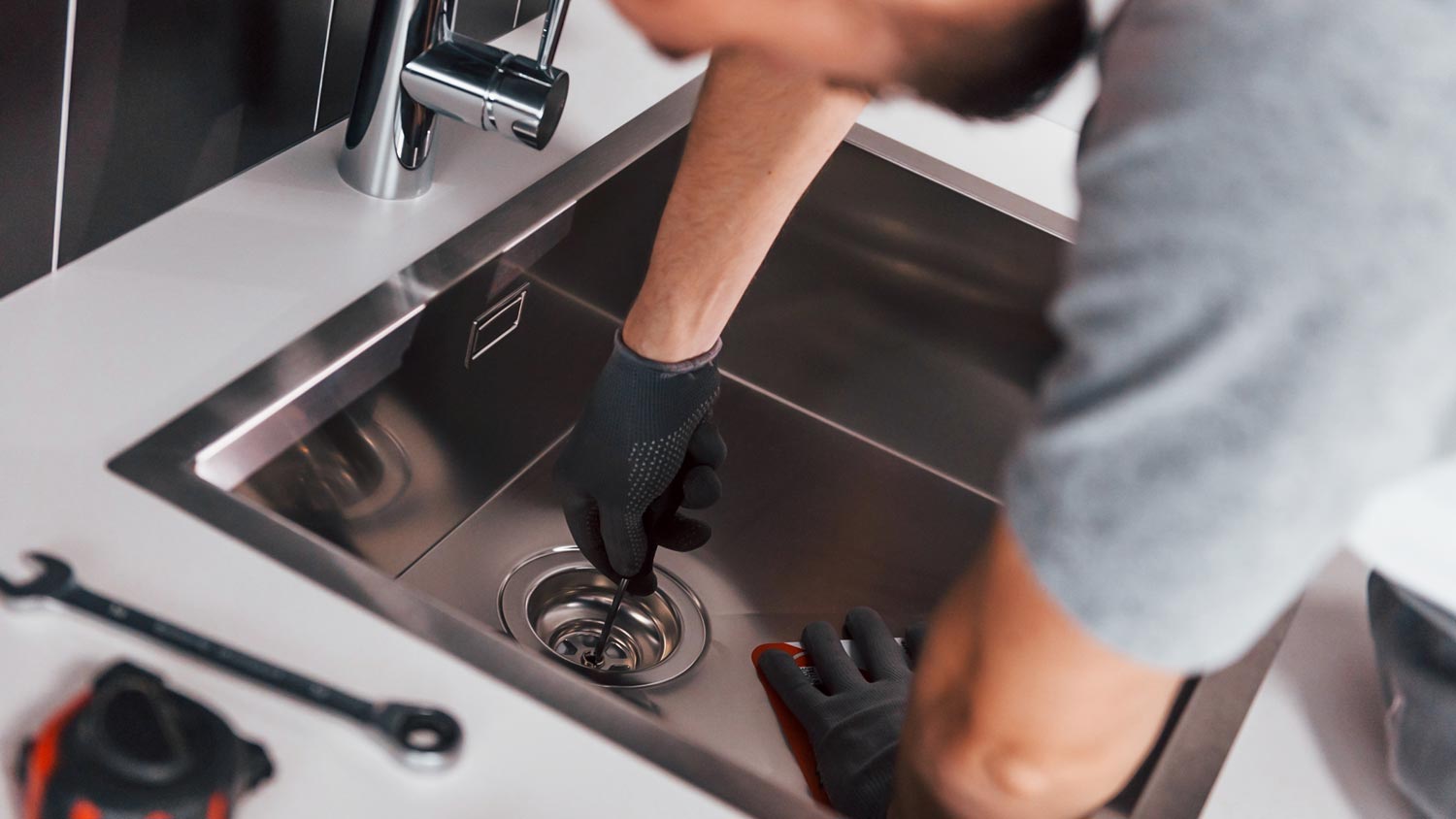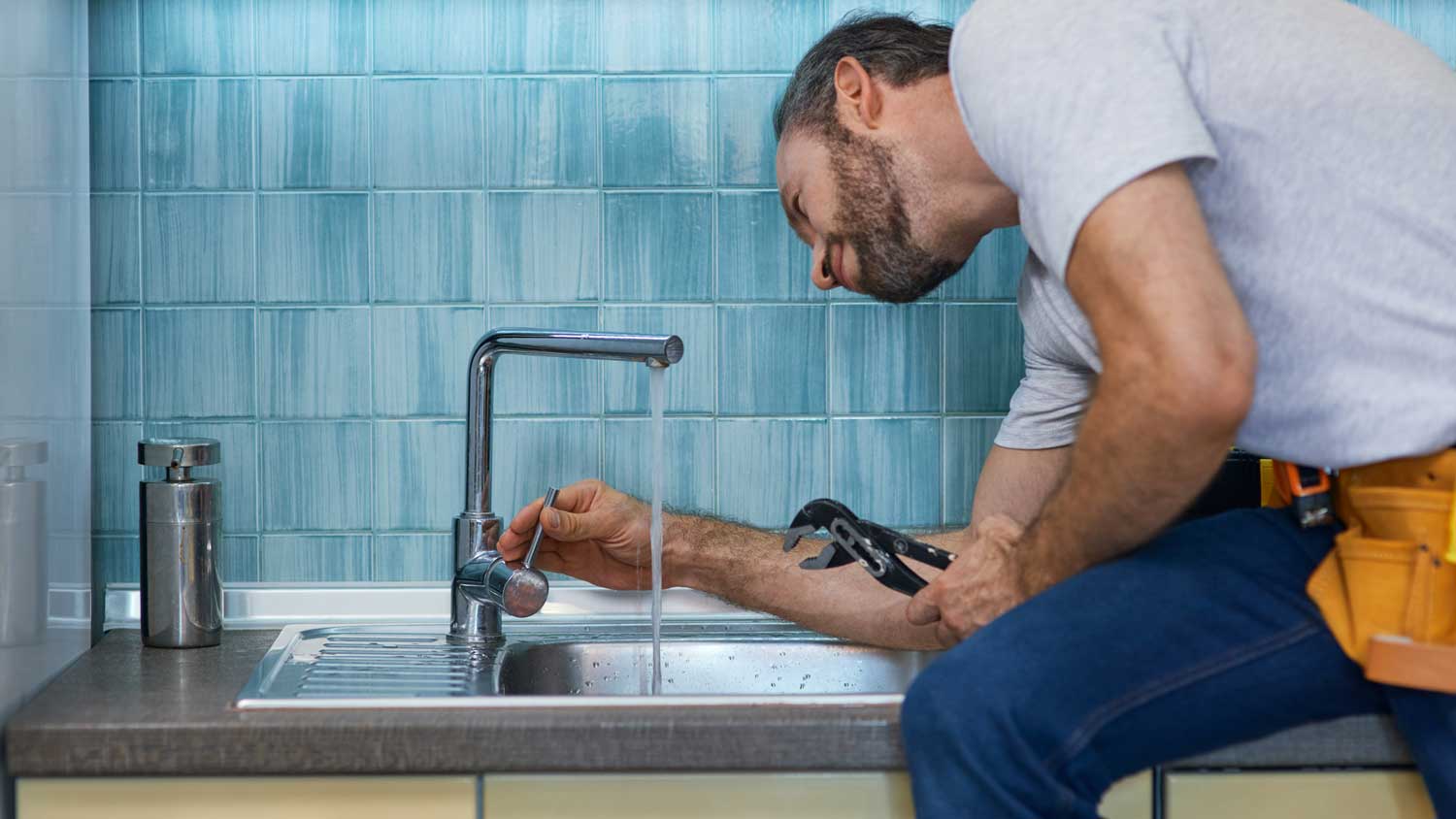How to Install an Undermount Sink Like a Pro
Everything but the kitchen sink doesn’t apply here


Whether you’ve finally had enough of your outdated sink fixture or your home is ready for a major kitchen renovation, learning how to replace and install an undermount sink is an effective way to add to your kitchen’s personality. However, knowing how to swap out your old sink may not be as straightforward as you think. Before you bring in a pro to tackle this project, here’s a step-by-step guide to replacing and installing an undermount sink.
Why Should I Install an Undermount Sink?
An undermount sink is a sink that’s installed completely under the counter. These sinks are fitted under a custom hole with none of its edges appearing above the counter, creating the look of a seamless, rimless sink. They may not work for everyone, but their appeal is obvious. Not only do undermount sinks add a modern style to the home, but they’re also highly customizable. With options for stainless steel, porcelain, and more, its versatility makes it ideal for matching the style of most kitchens.
Undermount sinks also require deciding whether you want more cabinet space or counter space. If you prefer counter space, installing an undermount sink can be the best choice for your kitchen. These low-sitting sinks will take up a lot of the available cabinet space under your sink, but their edges won’t take up any extra space on your counter.
Because of its versatility, seamless design, and extra space, an undermount sink can add to your home’s resale value.
How to Prep for Replacing and Installing an Undermount Sink
Before you start taking apart your old sink and swapping it out with your brand-new one, there are some steps you should take to prepare for success. These include inspecting the old sink, preparing for leaks or drips, measuring, and choosing your new sink.
Inspect Your Old Sink
Use your existing sink to your advantage by taking a detailed look at the current setup. You’ll want to ensure your sink isn’t on plywood; rather, there should be adhesive on the counter for this project to work without damaging the existing counter surface.
You should also see mounting clips that hold the sink in place. Make sure you can reach the clips to avoid searching for a ratchet extender. You may want to take pictures of the current setup to help you mimic a similar configuration when it’s time to install the new sink.
Be Prepared for Drips
Tinkering with plumbing fixtures can be messy. Prevent your floors and cabinet under the sink from getting wet by having buckets and extra absorbent rags on hand to catch and absorb any drips and leaks that may arise.
Choose the Right New Sink
There’s no getting around it: undermount sinks are heavy. The materials you choose for your undermount sink can also impact its weight, making it harder—or easier—to install.
Kitchen sink materials like cast iron, granite composite, quartz, slate, and porcelain are heavy and may require additional support, like extra mounting hardware. Acrylic, copper, and stainless steel are lightweight and may take less time and materials to install.
Measure for an Undermount Sink Replacement

The easiest way to measure for a new undermount sink is by taking measurements of the sink you already have. If you plan on changing the depth of your sink, avoid purchasing a sink that is too deep for your cabinet.
To measure your undermount sink size, measure the following:
The length from the outside of the rims
The width from the front to the back
All four sides across the rim or lip of your sink
The depth of your sink from the underside to the top rim
How to Replace an Undermount Sink
Turn Off the Water Supply Lines
Locate your water supply lines. While you can turn off the main water supply, the kitchen sink shut-off valves are located under the sink.
Turn off the hot and cold valves. Trace the water lines from the faucet to locate the knob or lever on each of the two pipes. If you’re dealing with a knob, turn it clockwise to turn it off. For a lever, it needs to be perpendicular to the pipe to be in a closed position. Turn the lever so it forms a right angle with the pipe.
Drain the Remaining Water in the Faucet
Turn the faucet on to run any remaining water out of the pipes. This will help you avoid messy leaks while you work or when you remove the faucet.
Disconnect Your Plumbing Fixtures
Disconnect the water supply lines. They connect at the sink and the water shut-off valves. Use a wrench to loosen the metal nuts on the water line. Have your bucket and dry rags ready to catch any water that drips or leaks and wipe up any messes.
Disconnect your drain pipe. Using channel lock pliers or an adjustable wrench, loosen the plastic nut — without separating the pipe — that attaches the metal sink strainer to the drain pipe. Loosen the slip nut on the P-trap – it’s the U-shaped or J-shaped piece of pipe — until you can remove the entire piece of pipe between the strainer and P-trap.
Remove the Garbage Disposal (Optional)

Unplug your garbage disposal from the GFCI electrical outlet. Water and electricity don’t mix, so disconnecting your garbage disposal can protect you from the risk of electrocution.
Remove your garbage disposal. Disconnect your garbage disposal from your drain pipe by undoing the main connection between them. This may require a screwdriver or Allen wrench. Make sure to hold the bottom of the disposal as you loosen and remove it.
Disconnect the Dishwasher (Optional)
Unplug the dishwasher from the drain line.
Move any plugs away from the area to avoid electrocution.
Tape the protruding cords up and out of the way if you can’t fully remove the dishwasher from the vicinity.
Loosen the Old Sealant
Using a utility knife, glide your knife around the edges of your sink to cut through the sealant.
Unscrew the Mounting Clips
Have someone else hold the sink up for you. Undermount sinks are heavy and shouldn’t be handled alone. If you don’t have help, use a sturdy two-by-four wooden board to hold the sink in place.
Check underneath your sink and countertops for metal clips.
Use a socket ratchet to unscrew the clips.
Remove the Sink
From below, gently push the sink up to remove it. If it doesn’t budge, wiggle it from side to side until you can remove it without damaging your countertop.
Clean Off the Old Caulking
Remove the old caulking. Use a razor scraper to slowly and gently remove old silicone sealant from the countertop. Take your time – you don’t want to damage your countertop!
Fit the New Sink
Double-check that your new sink fits the space.
Add Fresh Silicone to the Rim of the New Sink

Use a caulk gun to apply a consistent bead of caulking adhesive to the entire rim of your new sink.
Carefully —with a helper — lift the sink up to the underside of the countertop.
Clamp the Sink
Place a long two-by-four board across your counter on two folded towels. This will protect your countertop.
Pull a bar clamp through the drain hole and secure it to the two-by-four.
Place a smaller two-by-four block of wood on the underside to clamp the sink down without damaging it.
Tighten the clamp until it’s holding the sink firmly in place.
Install the Mounting Clips
Attach and secure the mounting clips to the sink using a ratchet.
Clean the Site
Use an old rag and some denatured alcohol to wipe the countertop, clean the sink, and remove excess caulking where the sink makes contact with the counter.
Let the Caulk Set
Make sure your sealant has a full 24 hours — or more — to cure. Default to the instructions on the sealant and your sink’s manual.
Remove the Clamp
Loosen the mounting clips and remove them.
Remove the wooden boards from the sink.
Reconnect the Fixtures and Appliances

Install your fixtures and appliances that you previously disconnected, including the faucet, pipe fittings, garbage disposal, and dishwasher.
Tips for Dealing With An Undermount Sink
In the process of learning how to install a kitchen sink, you’ll find that Installing an undermount sink isn’t necessarily a job for a beginner. It’s an advanced-level DIY that can be challenging and requires quite a few supplies and know-how. If you’re ready to tackle this project, use these tips to help you install, replace, and manage your undermount sink:
Choose a strong, solid countertop that is durable, weight-bearing, and water-resistant — like quartz — to help support the weight of the sink.
Thoroughly clean the underside of your countertop, as unclean surfaces can weaken the bond and cause it to weaken.
Use a high-quality sealant to avoid serious leaks in the future.
Zero reveal undermount sinks — where the opening of the sink sits flush with the countertop — are easier to clean.
If your countertop hasn’t been attached to your base cabinets, install the sink to the countertop first.
Have someone on hand to help you with holding the weight of the sink.
DIY vs. Hiring a Pro
If you decide to DIY your undermount sink replacement, then you could save between $175 and $325 on your project. A local professional plumber may charge anywhere between $50 and $200 per hour to replace a sink.
While it might save you money to do it yourself, this project is an advanced DIY because of the sheer weight of the sink and the fact that you’re working with water near electrical wiring. To be on the safe side, you might still wish to enlist the help of a trained plumber who can recommend the best products and save you from costly mistakes.
Frequently Asked Questions
Whether or not you can replace an undermount sink without removing the countertop depends on the type of countertop you have. Removing an old sink from granite countertops is relatively easy without removing the countertop, but other materials like laminate, or unusually shaped countertops, may need to be removed or modified.
Yes, you can remove an undermount sink from granite countertops. However, it’s safest to hire a granite pro to take on this job. Your pro might have to make cuts and grind the granite to remove the sink. Plus, if you’re replacing your sink with a larger one, you’ll need your pro to enlarge the existing sink cutout in your granite.





- Gas Plumbers
- Plumbing Repairs
- Sump Pump Installation
- Wood & Pellet Stove Repair
- Shower Repair
- Wood Stove Services
- Emergency Plumbers
- Fire Sprinkler Contractors
- Perc Test Companies
- Toilet Repair & Installation
- Boiler Repair
- Sewer Line Repair
- Faucet Repair
- Main Drain Camera Companies
- Foundation Drain Installation
- French Drains
- Bathtub Replacement
- Subcontractors
- Storm Drain Contractors
- Affordable Plumbing
- Plumbing & Heating Companies
- Bathroom Repair Services
- Sink Installation
- Commercial Plumber
- Barndominium Builders
- Water Line Repair
- Faucet Installation
- Water Line Installation
- Leak Detection
- Who Do I Hire When I Need My Undermount Sink Repaired?
- How to Install a Sink: A Step-by-Step Guide
- Types of Kitchen Sinks: Pros, Cons, and How to Choose One
- How to Install a Bathroom Sink in 5 Steps
- Who To Call To Fix Leaks Under Sinks
- Common Kitchen Sink Depths and How to Choose One
- What Adhesive Should You Use to Attach Your New Sink to the Vanity?
- How to Install a Kitchen Sink Drain in 10 Simple Steps
- Sink Your Teeth Into Granite Sink Cutouts
- 6 Reasons Your Bathroom Sink Is Draining Slowly and Potential Solutions










